-
Equipment and Tools
-
Aerial Work Platforms, Scaffolding And Ladders
- See all
- Atrium Lift
- Cranes / Boom Trucks
- Electric Scissorlifts
- Low-Level Access
-
Manlift Articulating
- See all
- Manlift Articulating 120' - 135' Combustion
- Manlift Articulating 30' - 39' Combustion
- Manlift Articulating 30' - 39' Electric
- Manlift Articulating 34' - 39' Towable
- Manlift Articulating 40' - 49' Combustion
- Manlift Articulating 40' - 49' Electric
- Manlift Articulating 50' - 59' Towable
- Manlift Articulating 60' - 69' Combustion
- Manlift Articulating 60' - 69' Electric
- Manlift Articulating 80' - 89' Combustion
- Manlift Straight Boom
- Mast Boom Lift
- One Man Drivable
- One Man Push Arounds
- Power Accessories
- Rt Scissor
- Scaffolding And Ladders
- Straddle Adapter
-
Air Compressors And Air Tools
- See all
- Air Compressor Aftercoolers / Filters / Separators / Dryers
-
Air Compressors
- See all
- Air Compressors 1000cfm - 1300cfm
- Air Compressors 1000cfm - 1300cfm Instrument Quality
- Air Compressors 1500cfm - 1800cfm Instrument Quality
- Air Compressors 300cfm - 400cfm
- Air Compressors 300cfm - 400cfm Instrument Quality
- Air Compressors 5cfm - 85cfm
- Air Compressors 600cfm - 900cfm
- Air Compressors 600cfm - 900cfm Instrument Quality
- Air Compressors 90cfm - 250cfm
- Air Compressors Electric 100cfm - 1000cfm
- Air Compressor Accessories
- Air Impact Wrenches
- Air Nailers & Staplers
- Air Tools - Contractor
- Air Tools - Demolition
- Air Tools - Industrial
- Compaction
-
Concrete And Masonry
- See all
- Battery Powered Saw
- Concrete - Finishing Equipment
- Concrete - Surface Preparation Equipment
-
Concrete / Masonry - Cutting & Drilling Equipment
- See all
- Concrete& Asphalt Floor Saws - Push Type
- Concrete And Masonry Blades
- Concrete Dowel Drills
- Core Drill Bits
- Crack Chasers
- Cutoff Saws Hand Held/ Gas/ Air/ Electric/ Hydraulic
- Diamond Chain Saws
- Diamond Core Drills
- Early Entry Concrete Saws
- Masonry Saws
- Street Saws Self-Propelled
- Tile Saws
- Concrete Water Accessories
- Concrete / Masonry - Mixing & Placing Equipment
-
Cooling, Heating, Drying And Indoor Air Quality
- See all
- Air Management - Accessories
- Air Management - Air Scrubbers
- Air Management - Dehumidifier
- Air Management - Fans & Blowers
- Boilers
- Cooling - Air Conditioning
- Cooling - Air Handlers
- Cooling - Chillers
- Cooling - Cooling Tower
- Cooling - Spot Cooler
- Fans / Blowers / Ventilators
- Heating - Accessories
-
Heating - Direct Fired
- See all
- 201k-300k Btu Kerosene Heater Dir
- 20k-80k Btu Kerosene Heater Dir
- 301k-400k Btu Kerosene Heater Dir
- 301k-400k Btu Lp/Ng Heater Dir
- 40k-70k Btu Kerosene Heater Dir
- 81k-200k Btu Kerosene Heater Dir
- Propane Convection& Radiant Heaters 22k - 200k Bt
- Propane/Natural Gas Direct-Fired Heaters 30k-2.5m
- Heating - Electric
- Heating - Flameless
- Heating - Hydronic / Ground
-
Heating - Indirect Fired
- See all
- 1000k Btu And Up Kerosene Heater
- 1000k Btu And Up Lp/Ng Heater
- 1mil - 5mil Btu Diesel Heater
- 201k-300k Btu Kerosene Heater
- 301k-400k Btu Kerosene Heater
- 301k-400k Btu Lp/Ng Heater
- 401k-500k Btu Kerosene Heater
- 401k-500k Btu Lp/Ng Heater
- 501k-999k Btu Diesel Heater
- 501k-999k Btu Kerosene Heater
- 501k-999k Btu Lp/Ng Heater
- 81k-200k Btu Kerosene Heater
- Heating - Steam / Hot Water
-
Earth Moving
- See all
- Backhoe Loaders
- Dozers & Crawler Loaders
- Excavators
- Hydraulic Breakers & Demolition Attachments
- Mini Excavators
- Motor Graders
- Rental Vehicles
-
Skidsteer Loaders
- See all
- Compact Skidsteer Loader
- Skidsteer Loader 999lb& Under
- Skidsteer Loader 1000-1499lb
- Skidsteer Loader 1100-1500lb Track
- Skidsteer Loader 1500-2000lb
- Skidsteer Loader 1500-2100lb Track
- Skidsteer Loader 2000-2800lb
- Skidsteer Loader 2100-2800lb Track
- Skidsteer Loader 2800-3200lb Track
- Ride On Skidsteer Attachments
- Skidsteer Attachments
- Tractors & Landscape Loaders
- Trenchers
- Wheel Loaders
- Floor Care
-
Forklifts
- See all
- Forklift Accessories
- Forklifts - Industrial
- Forklifts - Straight Mast Rt
- Forklifts - Telehandler
-
Material Handling Equipment
- See all
- Aluminum Dockplates
- Aluminum Loading Ramps
- Appliance Trucks
- Banding Kits
- Cricket Pipe Dolly
- Dry Wall Lift& Carts
- Duct Jacks/ Genie Material Lifts
- Glass Manipulators
- Grasshopper Pipe Dolly
- Hand Trucks
- Hilman Rollers/ Roller Skid Systems
- Hydraulic Rol-A-Lift
- Johnson Bar/ Pry Dollies
- Load Binders
- Pallet Pullers
- Pallet Trucks
- Platform Trucks
- Roust-A-Bout Portable Lift
- Stairclimbing Motorized Hand Trucks
- Warehouse Dolly
-
General Construction Tools
- See all
- Abrasive Blasting Equipment
- Batteries And Chargers
- Battery Powered Air Compressor
-
Battery Powered Tools
- See all
- Angle Grinders - Battery
- Circular Saws - Battery
- Compound Miter Saws - Battery
- Drywall Screwdrivers - Battery
- Hand-Held Band Saw - Battery
- Hand-Held Drills - Battery
- Impact Wrenches - Battery
- Miscellaneous - Battery
- Nailers - Battery
- Orbital Sanders - Battery
- Portable Table Saw - Battery
- Reciprocating Saws - Battery
- Rotary And Demolition Hammers - Battery
- Battery Powered Vacuum
- Chain Hoists & Air Winches
- Conveyors
- Drain & Sewer Cleaning & Inspections
-
Electric Tools
- See all
- Angle Grinders
- Belt Sanders
- Circular Saws
- Compound Miter Saws
- Die Grinders
- Drywall Screwdrivers
- Hand-Held Band Saw
- Hand-Held Drills
- Heat Gun
- Impact Wrenches
- Jigsaws
- Magnetic Drills
- Orbital Sanders
- Planers
- Portable Table Saw
- Reciprocating Saws
- Rotary And Demolition Hammer Accessories
- Rotary And Demolition Hammers
- Routers
- Shears& Nibblers
- Stationary Chop Saw
- Hydraulic / Electric Torque Wrenches / Enerpac
- Hydraulic Cylinders / Enerpac Jacking Systems
- Hydraulic Pumps / Enerpac
- Hydraulic Tools / Enerpac
- Industrial Vehicles
- Jacks - Bottle / Screw / Toe Jack
- Laser & Optical Levels
- Lighting Equipment
-
Mechanical & Electrical Contractor Trade Tools
- See all
- Cable Feeder
- Cable Reel Roller - Electric
- Cable Reel Stands/ Spindles
- Chain Vice/ Tri-Stand/ Pipe Stands
- Crimping Tools - Electric
- Crimping Tools - Manual
- Electric Cable Pullers& Sheaves
- Electric Conduit Benders
- Electric Pvc Heaters/ Pvc Benders
- Geared Threader/ Hog Head
- Hole Cutting Tool
- Hydraulic Conduit Benders
- Hydraulic Punch Drivers/ Knockout Sets
- Manual Pipe Tools& Accessories
- Mechanical Conduit Benders
- Pipe Threaders - Electric
- Power Fish System
- Power Pipe Cutters
- Victaulic Roll Groovers
- Wire Carts/ Dispensers
- Miscellaneous
- Paint Sprayers
- Pressure Washers
- Siding Brake
- Site Services
- Storage Containers / Jobsite Storage
- Traffic Safety Equipment
- Trailers
- Welding & Plasma Cutting Equipment
- Generators And Accessories
- Ground Protection
-
Lawn, Landscape, And Tree
- See all
- Battery Powered Lawn & Landscape
-
Lawn & Landscape
- See all
- Backpack Sprayer
- Bed Edger/ Trencher
- Chain Saws
- Garden Tillers
- Gas-Powered Drill
- Hand Tools
- Hand-Held Metal Detector
- Hedge Trimmers
- Hydroseeder
- Lawn Aerators
- Lawn Dethatchers
- Lawn Mowers& Brush Cutters
- Lawn Overseeder
- Lawn Spreader& Roller
- Lawn Vacuum
- Leaf Blowers/ Mulchers
- Log Splitter
- Post Driver
- Post Hole Augers
- Sod Cutters
- Straw Blowers
- Trimmers& Pruners
- Wheelbarrows
- Stump Grinders
- Wood & Brush Chippers
- Load Banks
- Portable Ice Rinks And Pathways
- Pumps
- Refrigeration
- Temporary Containment Walls
- Temporary Fencing
- Temporary Structures
- Trench And Shoring Equipment
-
Aerial Work Platforms, Scaffolding And Ladders
-
-
Industry Solutions
Agriculture Equipment Amusement Theme Parks Automotive Equipment Aviation Equipment Civil Commercial Construction Equipment Educational Facility Equipment Emergency Restoration and Response Entertainment Venue EquipmentEvent Rentals Film & TV Production Golf Course Management Equipment Government Services Healthcare Hospitality Equipment Industrial Manufacturing Equipment Marine EquipmentMining Equipment Oil Gas Equipment Real Estate and Property Maintenance Retail Maintenance Equipment Stadium Maintenance & Cleaning Equipment Utility Services
-
Industry Solutions
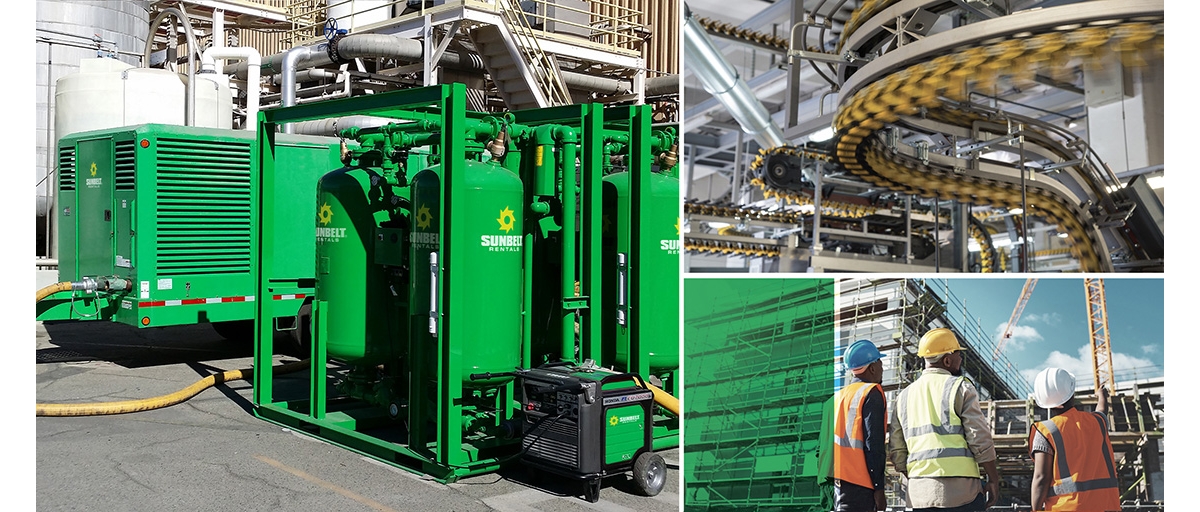
Your Guide to Air Compressors for Manufacturing and Industrial Facility Builds
Air compressors have earned their reputation for high output and efficiency. These easy-to-operate devices, used to supply the airflow that powers pneumatic equipment, are valuable assets for a wide range of processes during manufacturing and industrial construction, from powering air tools and HVAC systems to fueling packaging and automation equipment. It’s no wonder that the global portable air compressor market is expected to rise at a compound annual growth rate of 5.35% from 2022 to 2028.
Sunbelt Rentals offers a wide range of air compressor equipment to meet the needs of your manufacturing and industrial construction projects. But how do you choose? Read on for an in-depth look at air compressors, including:
- The basics of air compressors
- How to achieve your required cubic feet per minute and pressure in pounds per square inch
- How to operate an air compressor
- Air quality and condensate management
- Hose connectors and sizing
- OSHA valves
The Basics of Air Compressors
Air compressors typically use:
- An electric, diesel, or gas motor to drive the unit
- An inlet valve and a discharge valve to pull in and release air
- An air end to compress the air and, if necessary, a storage tank to hold it for use
The ratio is typically 8 to 1: The air compressor ingests 8 cubic feet of ambient air and compresses it to 1 cubic foot of compressed air. Next, a vacuum moves the air from the chamber into the storage tank. When the tank reaches its set or maximum-rated pressure, the compressor shuts off or unloads until it drops below the rated pressure. Note that a typical air compressor uses a 40-micron inlet filter, so the compressed air will contain particles, moisture, and oil droplets smaller than that.
Selecting the Right Size for Your Project
Every tool or device that uses an air compressor will include a recommended airflow in cubic feet per minute and pressure in pounds per square inch. This information is located on the serial tag.
Sunbelt Rentals offers air compressors in an extensive range of CFM and psi ratings to meet the needs of your manufacturing or industrial construction project, including values between 0- and 400-rated psi and 0 CFM and 1,600 CFM.
Air hammers, for example, may use 20 CFM at 90 psi, while manufacturing devices may require up to 1,600 CFM or even more. Automotive plants and other manufacturing facilities may use several stationary air compressors in tandem to provide thousands of CFM to run equipment.
An air compressor that is too large for the job will not cause a problem, because it will produce only the CFM the tool demands. But an air compressor that is too small for the task at hand will make the tool less efficient or prevent it from working at all.
Tip: Electric compressors can help you go green by eliminating diesel emissions, noise, smell, and the cost of fuel.
Wet Screw vs. Dry Screw
Air compressors use various schemes to compress air. For higher-pressure applications, dry screw and wet screw compressors are two of the most popular schemes. Both use rotors with screws that are closely mated but turn in opposite directions. The difference is that dry screw compressors don’t have oil between the screws, while wet screw compressors do.
Still, even dry screw compressors need lubrication for the bearings. Wet screw compressors are commonly used to compress air. Dry screw compressors are typically used to compress gases such as oxygen, nitrogen, or argon.
Diesel vs. Electric Drive
Air compressors typically use a diesel or electric drive to operate, and Sunbelt Rentals offers options for both.
In general, diesel drives can handle 185 CFM to 1,800 CFM of airflow and 90 psi to 500 psi of pressure. Diesel-powered air compressors will run between eight and 12 hours with the onboard fuel tank. You can add an auxiliary fuel cell to increase runtime. These air compressors may be either standard or instrument quality units, which we discuss further below.
Electric compressors in most rental fleets range from 50 horsepower to 450 horsepower and 90 psi to 175 psi. Larger electric compressors are available, if required.
To determine CFM, multiply the horsepower by 4. Do the math, and you’ll realize electric compressors can cover 200 CFM to 1,800 CFM. Electric compressors have built-in aftercoolers to handle condensate, so they don’t require additional cooling. However, more filtration or dryers can be installed if needed.
Electric compressors are an ideal solution when your site has power and you don’t want to pay for diesel fuel. But it’s critical to ensure properly sized breakers are available on-site.
How to Achieve Your Required CFM and psi
Before you rent an air compressor, you’ll need to know the volume of air and pressure your equipment requires.
CFM Calculations
To make sure you size your air compressor properly, you first need to know the total CFM of all tools you plan to use. For example, if you’re using two air hammers that each require 20 CFM, a jackhammer that needs 50 CFM, and a sandblaster that requires 80 CFM, you can sum up the CFM.
(2 × 20 CFM) + 50 CFM + 80 CFM = 170 CFM
Then multiply that by a safety factor of 1.5 to determine the air compressor size you need.
1.5 × 170 CFM = 255 CFM
Here, you’ll need an air compressor that provides at least 255 CFM.
If your needs are far greater, you can use multiple compressors in tandem, as long as you follow three basic rules:
- The psi must be the same on all compressors.
- Each compressor must have a check valve.
- The hose size and length should be adjusted to minimize friction loss.
Here are two examples of the calculations:
2 × 750 CFM compressors = 1,500 CFM compressor
375 CFM + 915 CFM + 1,600 CFM compressors = 2,890 CFM compressor
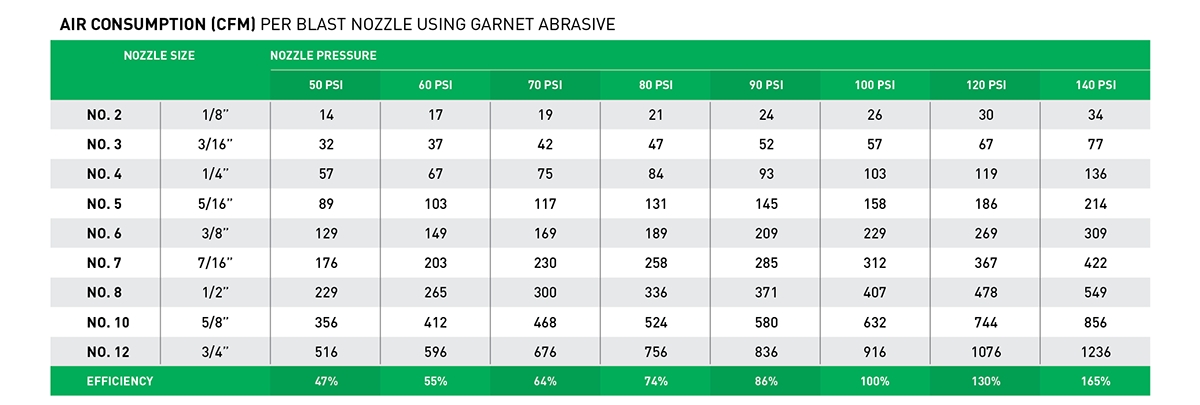
For sandblasting, you’ll also need to know how many blast nozzles you plan to use and the air consumption for nozzles of different sizes. You’ll be able to clean up charred wood in a residential application with a No. 2 nozzle, but sandblasting a 1-million-gallon tank at an oil refinery may call for two No. 12 nozzles to cover a wider path and work more efficiently.
Required psi
Standard air compressors generally provide 90 psi to 150 psi, with some offering as much as 200 psi. For many applications, this is sufficient, but there are also high-pressure compressors that provide 225 psi to 350 psi and extra-high pressure units that provide up to 500 psi. You’ll need to add a pressure regulator to achieve lower pressures using these units — for instance, if you need pressure lower than 90 psi on a standard compressor or 225 psi on a high-pressure compressor.
To create much higher pressure, you may need a booster compressor. These units typically come with a highly trained crew of experts due to the potential danger posed by extremely high pressure. To help you navigate the process, Sunbelt Rentals provides on-site expertise and support, including guidance on which air compressor model will help you achieve your desired psi for your project.
Tip: Ensure the pressure regulator is installed at your point of connection and not on the compressor itself.
How to Operate an Air Compressor
Operating an air compressor is easier than you think. Follow these steps to safely turn an air compressor on and off.
To start:
- Open all the doors on the air compressor and ensure there are no obstructions.
- Check the oil and water levels.
- Access the control panel and make sure the ball valve on the air outlet is closed.
- Start the unit. The compressor air gauge should come between 40 psi to 70 psi.
- Let the unit come up to idle rotations per minute, which is typically between 1,200 rpm and 1,400 rpm.
- Hit the service air button. At this point, the compressor should come up to set pressure.
- Open the ball valve slowly.
Warning: Never let the air compressor gauge go below the minimum operating parameters on the serial tag.
To stop:
- Close the ball valve on the air outlet, taking the load off. The unit will come down to idle speed.
- Let the unit sit for a minute or two while oils return to their usual location.
- Turn the unit off. The unit will depressurize.
Warning: Opening the ball valve too quickly can suck the oil out of the oil separator tank and/or damage the oil separator filter. Pressurize the system slowly to ensure all of your connections are good and nothing is leaking. This will also prevent oil from going downstream.
Air Quality and Condensate Management
Compressors pull in vast quantities of ambient air. A 1,600 CFM compressor, for example, will take in over 18 million cubic feet of air in 24 hours. All ambient air contains particulate matter, moisture, and oil, especially if diesel engines are running on your site. Contaminant concentration is low at the compressor intake, but with 8:1 compression of the air volume, it’s high at the compressor outlet, as the figure below shows.
Instrument Quality Air
The International Organization for Standardization has designated quality classes of air for different applications. Solids are measured in microns, moisture in dew point, and oil in parts per million.
Depending on your requirements, you may need instrument quality compressors with aftercoolers and/or dryers to achieve the required air quality. These compressors cool the compressed air to within 15°F to 20°F of ambient cooling air temperature, which is also known as “approach temperature.”
In addition, the instrument quality compressors will filter to achieve 0.01 microns for solids (Class 0) and 0.01 parts per million for oil (Class 2). This is critical to produce clean air and protect tools downstream from contaminants, such as aerosolized oil and microscopic dust particles. Maximum filtration can achieve 0.01 microns for solids and 0.01 ppm of remaining oil content. To achieve ISO Class 0, you can add filtration to achieve 0.001 ppm of remaining oil content.
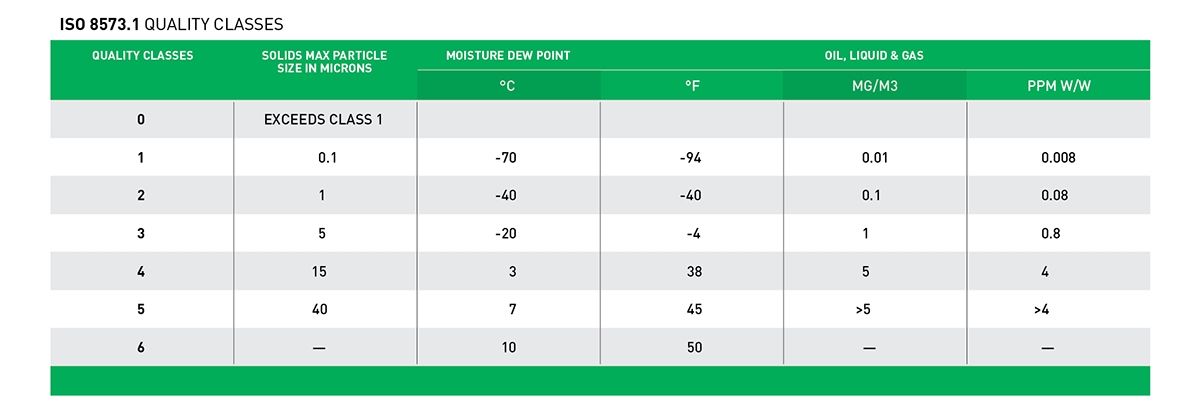
If your business is not ISO certified, you may choose instead to meet instrument air quality requirements per ANSI/ISA 3-1975 (R1981):
- Maximum particulate size of 3 microns
- Oil content not to exceed 1 ppm
- Dew point for indoor applications of 18°F below the lowest temperature the compressed air will be exposed to
- Dew point for outdoor applications of 18°F below the lowest record temperature for the local area
In addition to aftercooling and filtration, your application may require removing most of the moisture. Refrigerant dryers can achieve a dew point of plus 38°F/40°F with no air loss, but desiccant dryers can achieve a dew point of up to minus 100°F with up to 20% air loss. Desiccant dryers rely on activated alumina for their ability to remove moisture and achieve these extremely low dew points by removing water vapor.

Managing Condensate
Compressing air at atmospheric pressure reduces the amount of water that can exist in a vapor state. The excess water condenses into a liquid, which mixes with other contaminants in the air, along with lubricant from the compressor. The result is “condensate” — a slimy oil and water mix and a hazardous waste material. The amount of condensate depends on the temperature and pressure of the air, but be aware that an air compressor will produce more condensate in the heat of summer than on an icy winter day.
If your manufacturing or industrial jobsite is in a colder climate, you may need low ambient protection. If the air compressor is equipped with low ambient protection, make sure it’s plugged into a power source. If the air compressor doesn’t have low ambient protection, you may need to install it to prevent condensate from freezing.
In some cases, compressors use a zero-discharge condensate removal system to ensure no condensate taints the environment. Instrument quality air compressors sometimes discharge the condensate into the exhaust to evaporate back into the ambient, also ensuring no condensate is discharged on the ground.
At the opposite extreme, on some sites, the condensate may get dumped onto the ground and end up in the soil or in a storm sewer. The Environmental Protection Agency does not support this scenario, so make sure you capture any condensate before it spills.
Tip: If you rent a compressor, make sure that your accessories include a containment berm with ground protection matting to protect the berm. The technician who services the air compressor can use a vacuum system on the service truck to suck up the condensate and dispose of it in a tank. Or you can use a waste management system to clean up the condensate to the point where you can safely dispose of it in a storm sewer. Remember that electric compressors don’t have an exhaust system, so condensate will discharge on the ground unless you take precautions.
Hose Connectors and Sizing
To ensure you have the correct connectors and hose size for your application, you need to first ask what you’re connecting to. For example:
- Evaluate whether your project will involve National Pipe Thread, flange, or multiple connections.
- Then determine the hose coupling needed, such as Chicago, Crowfoot, or Boss.
- Finally, take a look below at the chart of distance versus pressure loss to ensure you select a hose that will work for your application.
For instance, suppose you want to push 180 CFM at 100 psi through a 3/4'' hose. The chart below shows no entry for those parameters, meaning they aren’t possible. But expand the size of the hose to a 1'', and for 180 CFM at 100 psi, the friction loss is 3.8 psi for every 50 feet of 1'' hose. If instead, you have 100 feet of 1'' hose, the friction loss would be double, or 7.6 psi.
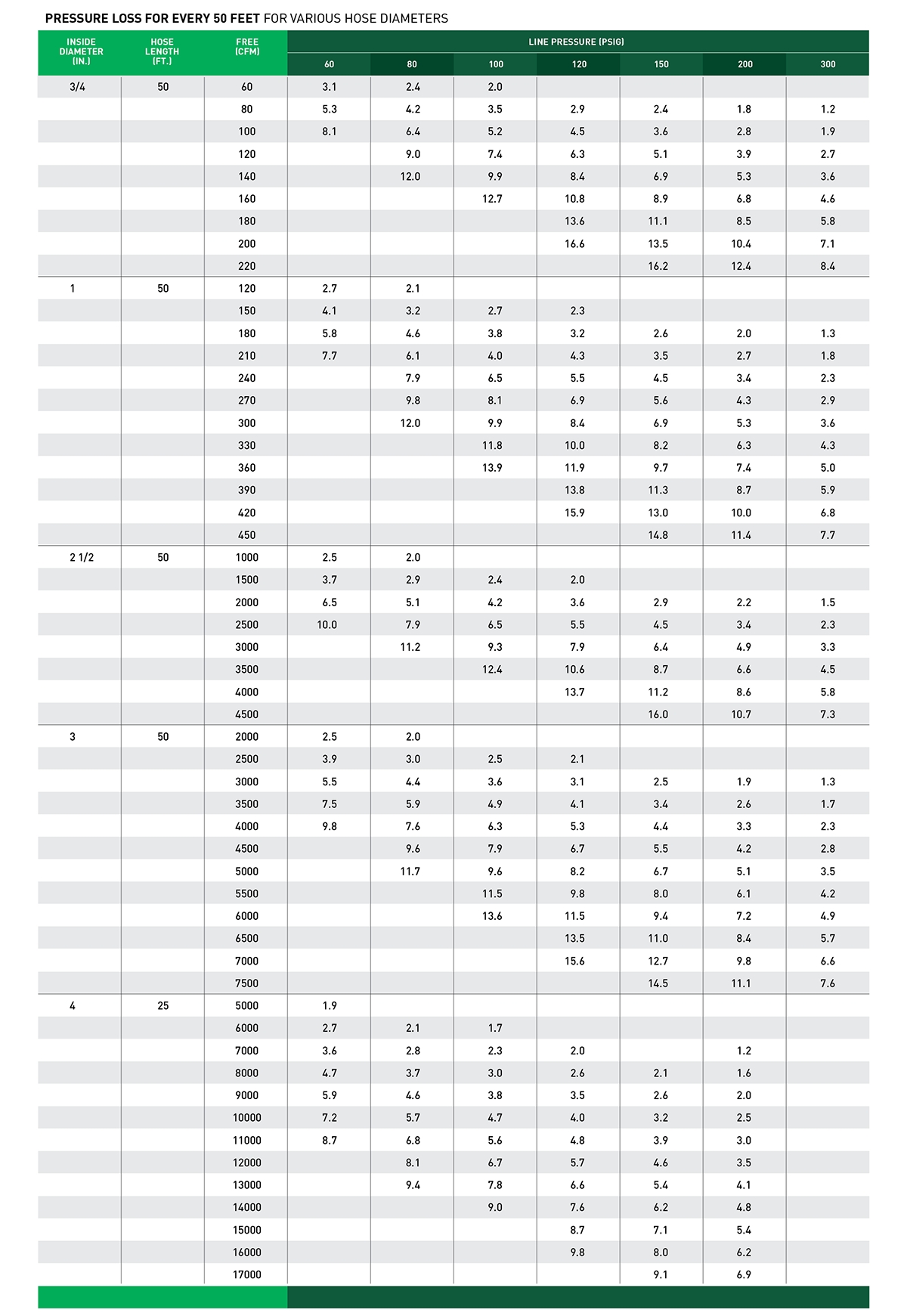
OSHA Valves
OSHA regulation 1926.302 requires safety devices at the source of the air supply at branch air lines. These safety check valves, also known as OSHA valves or air fuses, stop airflow when they detect a large flow loss and then reset when pressure equalizes in the air line. If a hose breaks, the valve stops air from flowing and protects against the hose whip.
Before you use an air compressor, determine whether you need a safety check valve. The valve must be sized per CFM of the devices connected to the air lines. You won’t need an OSHA valve if you’re connecting only one device that uses 100% of the airflow. Otherwise, you should have a manifold on your compressor that delivers the appropriate airflow to each pneumatic device connected — whether that’s 8 CFM, 10 CFM, or 100 CFM — with a valve for each one.
You must also use whip checks or chokers on all hose connections. These strong steel cables prevent hose whip in case of accidental separation from the coupling or clamp device. They must be installed with the hose in the extended position.
Whip checks are sized using the following formula:
(Hose diameter)² × 0.7854 × working pressure = force of impact
Here’s an example:
Assume a 3″ hose at 130 psi working pressure. Here’s the calculation of the impact force:
9 × 0.7854 × 130 psi = 919 lbs.
The impact ratings are as follows:
- 1/8″ cable = 500 lbs.
- 1/4″ cable = 1,750 lbs.
- 3/8″ cable = 3,600 lbs.
In this case, you should use a 1/4″ cable. Sunbelt Rentals uses 1/4″ safety cables for normal compressed air applications and 3/8″ safety cables for high-pressure air applications. If applications run above 500 psi, the 3/8″ safety cable will not be sufficient.
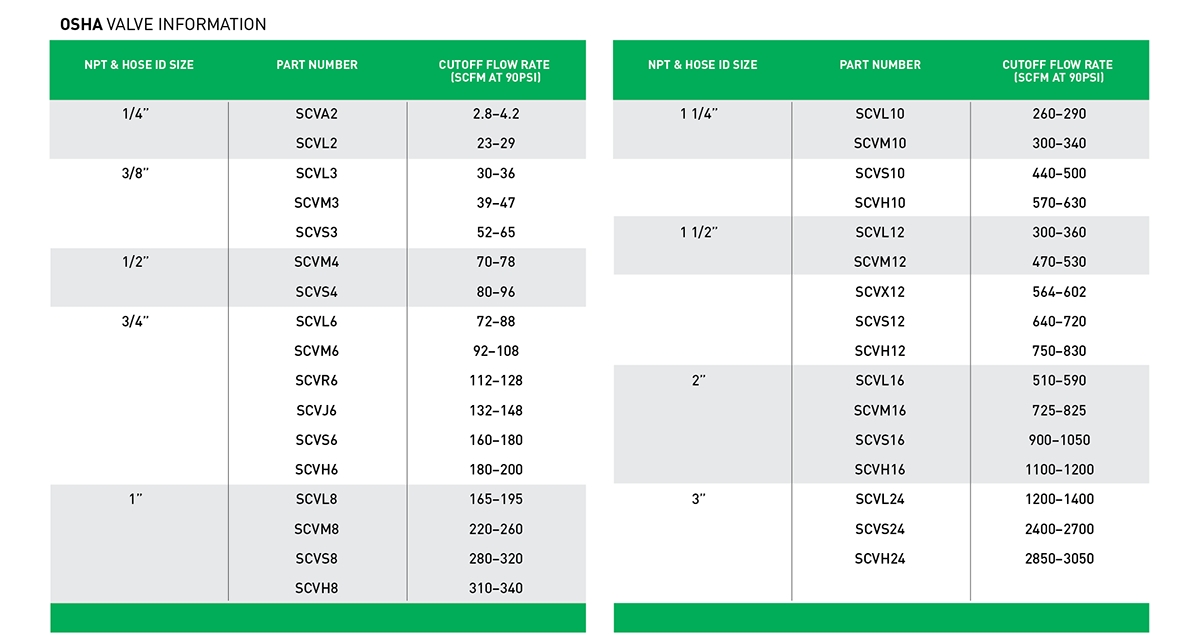
Partner with an Expert
At Sunbelt Rentals, we have the right team in place to help you navigate every challenge. Available 24/7, we’re here to help you determine the right air compressor(s) for your manufacturing or industrial facility project. Contact us today at 844-311-2973 or online to discuss your project needs and get answers to all of your questions.
Want more expert advice about air compressor use, size, and safety? Download our quick checklist with questions to consider before renting an air compressor.
